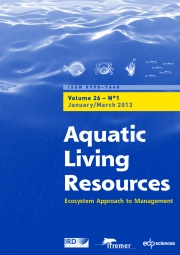Crossref Citations
This article has been cited by the following publications. This list is generated based on data provided by
Crossref.
Guan, Rui-zhang
and
Wiles, Peter Roy
1998.
Feeding ecology of the signal crayfish Pacifastacus leniusculus in a British lowland river.
Aquaculture,
Vol. 169,
Issue. 3-4,
p.
177.
Guan, Rui-Zhang
and
Wiles, Peter Roy
1999.
Growth and reproduction of the introduced crayfish Pacifastacus leniusculus in a British lowland river.
Fisheries Research,
Vol. 42,
Issue. 3,
p.
245.
Westman, Kai
Savolainen, Riitta
and
Julkunen, Markku
2002.
Replacement of the native crayfish Astacus astacus by the introduced species Pacifastacus leniusculus in a small, enclosed Finnish lake: a 30‐year study.
Ecography,
Vol. 25,
Issue. 1,
p.
53.
Light, Theo
2003.
Success and failure in a lotic crayfish invasion: the roles of hydrologic variability and habitat alteration.
Freshwater Biology,
Vol. 48,
Issue. 10,
p.
1886.
Stenroth, Patrik
and
Nyström, Per
2003.
Exotic crayfish in a brown water stream: effects on juvenile trout, invertebrates and algae.
Freshwater Biology,
Vol. 48,
Issue. 3,
p.
466.
NYSTRÖM, PER
2005.
Non‐lethal predator effects on the performance of a native and an exotic crayfish species.
Freshwater Biology,
Vol. 50,
Issue. 12,
p.
1938.
NYSTRÖM, PER
STENROTH, PATRIK
HOLMQVIST, NIKLAS
BERGLUND, OLOF
LARSSON, PER
and
GRANÉLI, WILHELM
2006.
Crayfish in lakes and streams: individual and population responses to predation, productivity and substratum availability.
Freshwater Biology,
Vol. 51,
Issue. 11,
p.
2096.
Harrison, Megan L.
Hoover, Trent M.
and
Richardson, John S.
2006.
Agonistic behaviours and movement in the signal crayfish,Pacifastacus leniusculus: can dominance interactions influence crayfish size-class distributions in streams?.
Canadian Journal of Zoology,
Vol. 84,
Issue. 10,
p.
1495.
Fonseca, Duane B
and
Sheehy, Matt RJ
2007.
Does size matter? A cautionary experiment on overoptimism in length-based bioresource assessment.
Canadian Journal of Fisheries and Aquatic Sciences,
Vol. 64,
Issue. 7,
p.
996.
Buřič, M.
Kozák, P.
and
Vích, P.
2008.
Evaluation of different marking methods for spiny-cheek crayfish(Orconectes limosus).
Knowledge and Management of Aquatic Ecosystems,
p.
02.
Pilotto, Francesca
Ghiani, Michela
Crosa, Giuseppe
Sena, Fabrizio
Free, Gary
and
Cardoso, Ana Cristina
2008.
The Invasive Crayfish Orconectes Limosus in Lake Varese: Estimating Abundance and Population Size Structure in the Context of Habitat and Methodological Constraints.
Journal of Crustacean Biology,
Vol. 28,
Issue. 4,
p.
633.
Nowicki, Piotr
Tirelli, Tina
Mussat Sartor, Rocco
Bona, Francesca
and
Pessani, Daniela
2008.
Monitoring crayfish using a mark-recapture method: potentials, recommendations, and limitations.
Biodiversity and Conservation,
Vol. 17,
Issue. 14,
p.
3513.
Peay, S.
Guthrie, N.
Spees, J.
Nilsson, E.
and
Bradley, P.
2009.
The impact of signal crayfish (Pacifastacus leniusculus) on the recruitment of salmonid fish in a headwater stream in Yorkshire, England.
Knowledge and Management of Aquatic Ecosystems,
p.
12.
OLSSON, KARIN
and
NYSTRÖM, PER
2009.
Non‐interactive effects of habitat complexity and adult crayfish on survival and growth of juvenile crayfish (Pacifastacus leniusculus).
Freshwater Biology,
Vol. 54,
Issue. 1,
p.
35.
Holdich, D.M.
Reynolds, J.D.
Souty-Grosset, C.
and
Sibley, P.J.
2009.
A review of the ever increasing threat to European crayfish from non-indigenous crayfish species.
Knowledge and Management of Aquatic Ecosystems,
p.
11.
Johnson, Matthew F.
Rice, Stephen P.
and
Reid, Ian
2010.
Topographic disturbance of subaqueous gravel substrates by signal crayfish (Pacifastacus leniusculus).
Geomorphology,
Vol. 123,
Issue. 3-4,
p.
269.
Hudina, Sandra
Galić, Nika
Roessink, Ivo
and
Hock, Karlo
2011.
Competitive interactions between co-occurring invaders: identifying asymmetries between two invasive crayfish species.
Biological Invasions,
Vol. 13,
Issue. 8,
p.
1791.
Gherardi, Francesca
Aquiloni, Laura
Diéguez-Uribeondo, Javier
and
Tricarico, Elena
2011.
Managing invasive crayfish: is there a hope?.
Aquatic Sciences,
Vol. 73,
Issue. 2,
p.
185.
MOORHOUSE, TOM P.
and
MACDONALD, DAVID W.
2011.
The effect of manual removal on movement distances in populations of signal crayfish (Pacifastacus leniusculus).
Freshwater Biology,
Vol. 56,
Issue. 11,
p.
2370.
zu Ermgassen, Philine S. E.
and
Aldridge, David C.
2011.
Predation by the invasive American signal crayfish, Pacifastacus leniusculus Dana, on the invasive zebra mussel, Dreissena polymorpha Pallas: the potential for control and facilitation.
Hydrobiologia,
Vol. 658,
Issue. 1,
p.
303.


